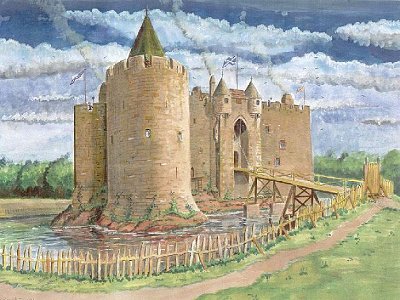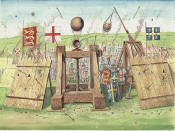|
Artist: Andrew Spratt Custodian of Dirleton Castle.
|
|
|
|||||||
With the extra magonels and trebuchets the castle walls were breached and entered by storm. Surprisingly, the De-Vaux were allowed to flee with their lives. By 1311, Dirleton was re-captured by the Scots and in accord with King Robert the Bruce's policy of slighting castles to prevent their use by the English, three of the great towers were thrown down to almost ground level and the upper levels of the remaining towers partly torn away. With the arrival of the Halyburtons, through marriage to the De-Vauxs in the 1350's.Dirleton was greatly rebuilt though not in such a grand scale as the original De-Vaux's plan. A new Halyburton gatehouse with conical roofed bartizans (like the original entrance to Dalhousie castle, near Bonnyrigg) was added to the south facing entrance. The postern east-facing gate was blocked up with a great hall/kitchen and storage vaults built across the stumps of three of the earlier towers. The base of these three towers can still be traced today. Not only did the Halyburtons leave their building work as testimony to their presence in history but they were also involved in many documented battles, events and plots too confusing to explain in any great detail. At the 1st battle of Nisbet in 1355 John Halyburton of Dirleton was killed while helping Ramsay of Dalhousie, Dunbar of Dunbar castle and Douglas of Tantallon castle defeat the English garrison from Norham castle. Surprisingly, a few years later in 1363 Douglas and Dunbar turned on the Halyburtons and seized Dirleton castle in their first steps of rebellion against King David II of Scots for his attack on Kildrummy castle. This led to the battle of Lanark where Douglas and Dunbar were defeated by King David and forced to sue for peace. Dirleton was then returned to the Halyburtons. The Halyburtons also have a connection to America through Janet Halyburton who was the second wife of Prince Henry Sinclair of Roslin. Who, in 1398, it is claimed along with Clan Gunn of Clyth castle in Caithness made the epic voyage of discovery to America, landing at Nova Scotia then on to Massachusetts. In fact, an effigy of Sir James Gunn of Clyth who died during this trip is still in existence, being known as the Westford Knight. At the 2nd battle of Nisbet in 1402 John Halyburton of Dirleton, along with the Lauders of North Berwick, The Hepburns of Markle/Hailes and the Cockburns were defeated and captured by the rebel Dunbars and their English ally the infamous 'Hotspur' Percy. Halyburton was kept in such detestable conditions before being ransomed that he died of 'loosening of the bowels' on his return home. The Halyburtons also helped the rebel Sinclairs of Herdmanston and the Douglases rout the Royal army at the battle of Long Hermiston Moor west of Edinburgh in 1407,in a confused plot to capture Prince James prior to his attempted flight to France with the Sinclairs of Roslin. It appears Scots families such as the Sinclairs would side with both factions, both Royal and rebel to 'wait and see' who would eventually win. That way they would always keep their lands whoever was in power. In the early 1500's Dirleton passed to the Ruthven family also through marriage. The Ruthvens also left their mark on the castle around 1550 by added the Ruthven Range (almost an exact copy of their Townhouse in Perth where the ' Gowrie Conspiracy' would take place in 1600), the stables, a Beehive Doocot and replaced the palisade around the castle-town with a Barmkin wall protected by gun-loops. The Ruthvens like their ancestors the Halyburtons made many appearances in the pages of history. The main events being their involvement in the murder of Mary Queen of Scots favorite David Riccio at Holyrood Palace in 1566. Their seizure of King James VI of Scots in 1582 at Ruthven castle, along with their alleged attempt to capture the King again in 1600 in the 'Gowrie Conspiracy'. Resulting in the deaths of the two Ruthven brothers and the capture of Dirleton by the King's forces. After passing through the hands of many other families Dirleton while held by the Maxwells, in 1650,was besieged by General Lambert on behalf of Oliver Cromwell. A mortar piece ripped open the Halyburton gatehouse and after a day's bombardment the castle was taken by storm. In 1663 the castle in a slighted state passed to the Nisbet family. They chose to abandon it as a residence and built a new modern house at Archerfield nearby. The castle fell into ruins but the gardens continued to develop in its shadow. Today the arts and crafts north garden is in the Guinness Book of records as the longest Herbaceous Border in the World being 215metres long with over 300 different types of plants. A rather peaceful end to a war-like castle. Dec 2001A.D.
|


